Content is from Kirkbride et al. 2006Kirkbride et al. 2006:
Kirkbride JH, Jr, Gunn CR, and Dallwitz MJ. 2006. Family guide for fruits and seeds, vers. 1.0. Accessed September 2020-January 2022. URL: https://nt.ars-grin.gov/seedsfruits/keys/frsdfam/index.cfm ., without modification.
Updates are forthcoming.
Cones: Dry; compound cone when dry (Spjut Fig. 23C-E & 2 families: Pinaceae, Welwitschiaceae); ovoidovoid:
3D shape—ovate , or globoseglobose:
, or globoseglobose:
3D shape—more or less spherical ; symmetrical, or asymmetrical; with scales; scales with separate subtending bracts. Fruiting scales present; dry; persisting; woodywoody:
; symmetrical, or asymmetrical; with scales; scales with separate subtending bracts. Fruiting scales present; dry; persisting; woodywoody:
texture—consisting mainly of indurate lignified tissues, characteristic of or resembling wood
.
Seeds: Arilaril:
(broad sense) appendicular structure that wholly or partly envelops a seed and is produced from or a modification of the funicle, raphe, or outer integument; usually fleshy or pulpy, sometimes spongy or tufted-capillate, often brightly colored absent. Seed larger than minute; 1 to less than 5 mm long, or 10 to less than 25 mm long; 4–21 mm long (without wing); oblongoblong:
absent. Seed larger than minute; 1 to less than 5 mm long, or 10 to less than 25 mm long; 4–21 mm long (without wing); oblongoblong:
2D shape—much longer than broad with nearly parallel sides, corners are rounded , or ovateovate:
, or ovateovate:
2D shape—egg-shaped in outline, widest point is towards one end of the organ, the other end tapers gradually, attachment at or near the broad end (compare obovate, ovoid)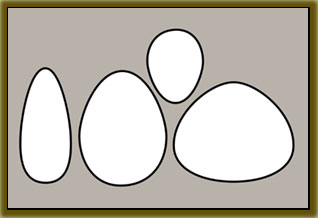 , or obovoidobovoid:
, or obovoidobovoid:
3D shape—obovate
; not bowl shaped; without winglike beakbeak:
a usually firm, terminal appendage, sometimes tapered ; without caudatecaudate:
; without caudatecaudate:
tapering to a long, tail-like appendage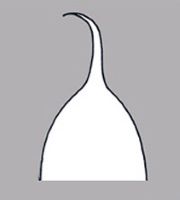 appendage(s); at maturity with food reserves; with endospermendosperm:
appendage(s); at maturity with food reserves; with endospermendosperm:
nutritive starch- and oil-containing tissue present in many seeds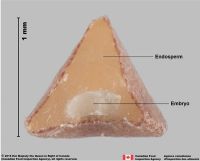 ; without canavanine. Sarcotestasarcotesta:
; without canavanine. Sarcotestasarcotesta:
pulpy or fleshy outer layer of the seed coat, simulates aril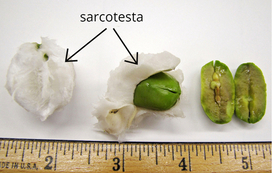 absent. Testatesta:
absent. Testatesta:
seed coat
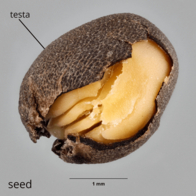 present; with markedly different marginalmarginal:
present; with markedly different marginalmarginal:
at, on, or close to the margin or border
tissue, or without markedly different marginalmarginal:
at, on, or close to the margin or border
tissue (rarely); marginalmarginal:
at, on, or close to the margin or border
tissue winglike; without fleshyfleshy:
texture—fairly firm and dense, juicy or at least moist, and easily cut
or leatheryleathery:
texture—moderately thick, tough, and very pliable
layer over hard layer; tight; shinyshiny:
uniformly reflecting a high proportion of incident light at all angles ; surface unsmooth; surface with merged raised features; surface roughenedroughened:
; surface unsmooth; surface with merged raised features; surface roughenedroughened:
texture—having a small, stout, stiff, more or less acute protrusions
(wings striatestriate:
surface relief—having fine, parallel lines, grooves or ridges ); without crease or line separating cotyledons from hypocotyl-radicle; without notch along margin where cotyledons from hypocotyl-radicle tip approach each other; resin with glands, or without glands; without bristles; glabrousglabrous:
); without crease or line separating cotyledons from hypocotyl-radicle; without notch along margin where cotyledons from hypocotyl-radicle tip approach each other; resin with glands, or without glands; without bristles; glabrousglabrous:
without hairs
; with wing(s), or without wings (few Pinus spp.); 1-winged (& wing arising from scalescale:
general term for short, thin, flat bracts or hairs
tissue); without collar; without operculumoperculum:
a dehiscent cap (or lid) of a seed or fruit that opens during germination or dehiscence
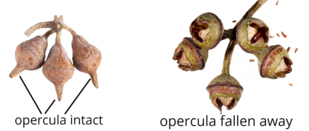 ; colored; monochrome; not becoming mucilaginousmucilaginous:
; colored; monochrome; not becoming mucilaginousmucilaginous:
resembling mucilage; moist and sticky
when wetted; surrounding food reserve. Hilumhilum:
on seeds, the scar indicating where the funiculus was attached; on grass caryopses, the scar visible on the outer fruit surface revealing where the seed is attached on the inner fruit wall surface; or in Asteraceae cypselae, the scar visible on the outer fruit wall revealing where the fruit was attached to the receptacle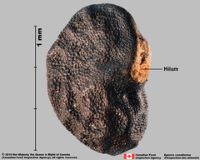 punctate. Endospermendosperm:
punctate. Endospermendosperm:
nutritive starch- and oil-containing tissue present in many seeds hard, or fleshyfleshy:
hard, or fleshyfleshy:
texture—fairly firm and dense, juicy or at least moist, and easily cut
; without starch; with oils; without fatty acid containing cyclopropene; without apicalapical:
at or pertaining to the end of the seed or fruit distal from its point of attachment (i.e., base)
lobes; without chlorophyll; without isodiametric faceted surface; without odor. Embryo differentiated from food reserve; well developed; 1 per seed (only 1 of several mature); partially filling testatesta:
seed coat
 (with food reserve); chamber basalbasal:
(with food reserve); chamber basalbasal:
at or pertaining to the point of attachment; (of embryo) embryo occupies one end of the seed
to wing; 0.8 times the length of food reserve (estimated); at one end of seed not extending into a depression or cup; axileaxile:
on or of the axis
and centric; linearlinear:
(shape) long, narrow, and uniform in width; (of embryo) embryo is straight and much longer than wide , or foliatefoliate:
, or foliatefoliate:
appearing leaf-like
; with spatulatespatulate:
2D shape—like a spatula; rounded at the apex, with base long and tapered; (of embryo) embryo is straight and axile and centric with the cotyledons expanded to form the shape of a spatula or spoon; (of cotyledons) cotyledons expanded and wider than the stalk but not invested into the stalk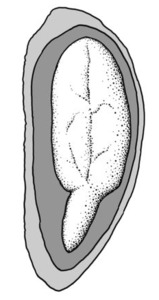 cotyledons (somewhat in some spp.); parallel to seed length; embedded in perispermperisperm:
cotyledons (somewhat in some spp.); parallel to seed length; embedded in perispermperisperm:
seed nutritive tissue comparable to the endosperm, but derived from the nucellus (maternal tissue)
; with cotyledons gradually connected to hypocotyl-radicle, or abruptly connected to hypocotyl-radicle (barely); without coleorhiza; without simmondsin; without stomata; not green; with 2 or more cotyledons. Cotyledons 2 to 11 (to 18); well developed; 0.4 times length of embryo; as wide as hypocotyl-radicle; 1–1.25 times wider than hypocotyl-radicle (estimated); not concealing hypocotyl-radicle; not foliaceous; thinthin:
having or being of relatively little depth
; flat; smooth; with apicesapex:
the point farthest from the point of attachment, or the "tip" of an organ entire; with margins separate; basally entire; equal in size; not punctatepunctate:
entire; with margins separate; basally entire; equal in size; not punctatepunctate:
surface relief—dotted with pits or with translucent, sunken glands or with colored dots, similar to pitted dotted. Hypocotyl-radicle well developed; straight; not thickened.
dotted. Hypocotyl-radicle well developed; straight; not thickened.
General references: Engler, A. & K. Prantl. 1924 and onward. Die Natürlichen Pflanzenfamilimien. W. Engelman, Leipzig, Gaertner, J. 1788–1805. De fructibus et seminibus plantarum. The Author, Stuttgart, Gunn, C.R., J.H. Wiersema, C.A. Ritchie, & J.H. Kirkbride, Jr. 1992 & amendments. Families and genera of Spermatophytes recognized by the Agricultural Research Service. Techn. Bull. U.S.D.A. 1796:1–500, Page, C.N. 1990. Coniferophytina (Conifers and Ginkgoids). In: Kubitzki, K., ed., The families and genera of vascular plants, pp. 282–361. Springer-Verlag, Berlin, Mabberley, D.J. 1987. The plant-book, 706 p. Cambridge University Press, Cambridge, Martin, A.C. 1946. The comparative internal morphology of seeds. Amer. Midl. Naturalist 36:513–660, Schopmeyer, C.S. 1974. Seeds of Woodywoody:
texture—consisting mainly of indurate lignified tissues, characteristic of or resembling wood
plants in the United States. Agric. Handb. 450:1–883, and Spjut, R.W. 1994. A systematic treatment of fruit types. Mem. New York Bot. Gard. 70:1–182.